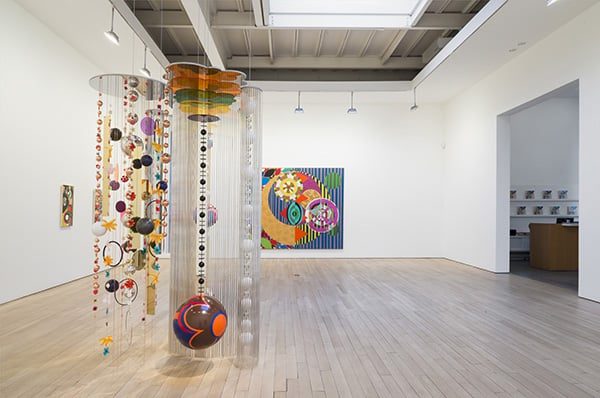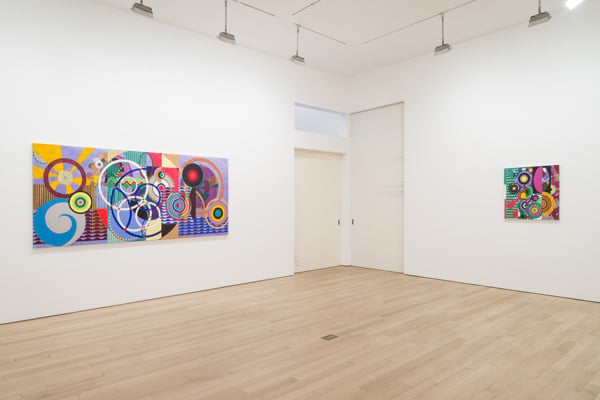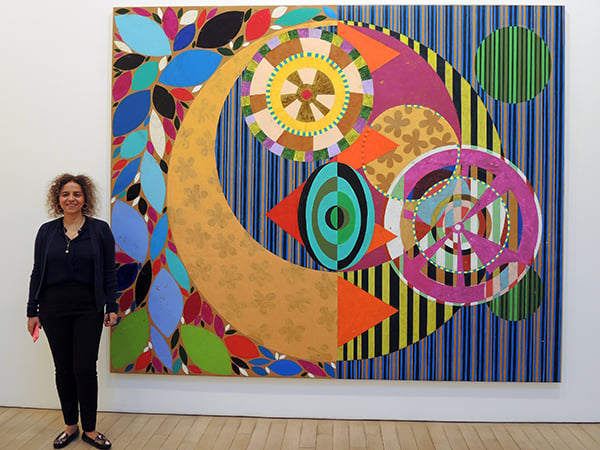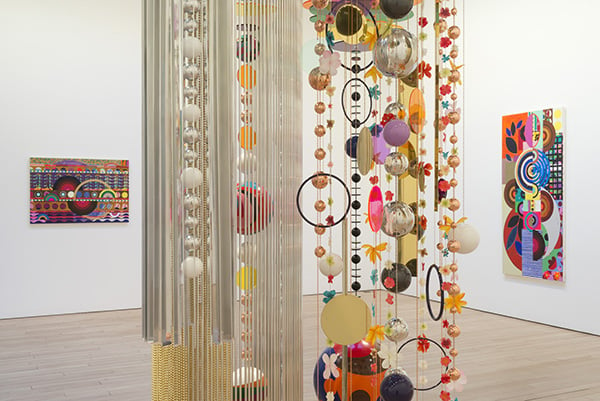Galleries
Beatriz Milhazes Debuts Wild New Sculptures at James Cohan
The artist branches out from painting with Carnival-inspired sculptures.

The artist branches out from painting with Carnival-inspired sculptures.

Sarah Cascone

There’s always been a flair for the dramatic in Brazilian artist Beatriz Milhazes’s work, but knowing that still doesn’t quite prepare you for the sight of her new sculptures, which appear almost as though one of her colorful paintings had been translated into three dimensions, hanging from the ceiling of New York’s James Cohan gallery.
This past year, Milhazes had her first North American retrospective, “Beatriz Milhazes: Jardim Botânica,” at Pérez Art Museum Miami, but she was holding out on viewers. The two mobile-like works on view in New York may be her first sculptures, but the pieces were roughly five years in the making, stemming from the artist’s longtime side job in set design for her sister’s contemporary dance studio.
Milhazes wasn’t initially sure anything would ever come of her explorations in sculpture, the results of which were fabricated at Pennsylvania’s Durham Press. “It’s an adventure,” Milhazes had warned the gallery, she told artnet News at a preview, saying that she had told Cohan, “I don’t know if I will make something happen.”

Beatriz Milhazes, “Marola” (2015),
installation view at James Cohan Gallery.
Photo: Adam Reich.
Inspired in part by the gaudy floats of Carnival in her native Rio de Janeiro, Milhazes has created cascading curtains of polyester flowers, stainless steel rods, and beads, including large aluminum ones hand-painted in enamel with her colorful floral designs, among other materials.
“I didn’t want it to become a mobile; that’s why it goes all the way to the floor,” she explained.
The sculptures are joined by a selection of Milhazes’ recent paintings, created using her signature method. She paints decals on plastic sheets, then transfers them to the canvas, a technique she has dubbed “monotransfer.” Milhazes compares it to traditional one-time-use-only monotype prints, the key difference being that where monotypes are wet, she is working with dry decals.

Beatriz Milhazes, “Marola” (2015),
installation view at James Cohan Gallery.
Photo: Adam Reich.
For the most part, Milhazes begins her works without any particular design in mind and without preliminary sketches, letting the work develop as she gradually adds more layers to the canvas. “It has a very strong link with the collage practice,” Milhazes said.
She credits seeing Bridget Riley‘s 2000–01 show at New York’s Dia Art Foundation for inspiring her to incorporate verticality and straight lines into her work. “Before, I was just engaging with the circle,” Milhazes explained. Though she still uses organic imagery, her later works make extensive use of the grid, and have become far more geometric.
Because she’s been working with the monotransfer process for so long, Milhazes’ studio is full of old decals, some as many as 10 or 12 years old, she said, all waiting to be incorporated into a new work.

Beatriz Milhazes with her painting Marcujola (2015) at James Cohan gallery.
Photo: Sarah Cascone.
It’s a process that can prove challenging. “Painting takes a lot of energy,” and “has a painful process,” Milhazes told the press at the preview.
Touring the exhibition, she reflected on the creation of Marotoloco, a small work in the gallery’s back room that she started with “nothing in mind” and “became kind of a mess actually,” before she was able to hit upon the right combination of shapes and colors—kind of an artistic alchemy.
“Sometimes,” said Milhazes, “I find myself a scientist, introducing new elements, new possibilities.” Her experiments, clearly, are working.

Beatriz Milhazes, “Marola” (2015),
installation view at James Cohan Gallery.
Photo: Adam Reich.
“Beatriz Milhazes: Marola” is on view at James Cohan, 533 West 26th Street, New York, October 22–November 28, 2015.